Overview of the Tver septic tank: device, principle of operation, advantages and disadvantages
In areas with private development, the absence of a central sewage system is not uncommon. Disposal of effluents is becoming a problem for home owners, and they increasingly prefer to equip their own treatment system. One of such solutions may be the Tver septic tank, which performs a full cycle of wastewater treatment.
But you must admit, before deciding to purchase a treatment plant, you need to study the unit’s design, understand the principle of its operation, get acquainted with the operational advantages and disadvantages. All these points are detailed in the article.
The content of the article:
How the Tver cleaning station works
Septic Tver is a local station for the complete treatment of domestic wastewater. The internal volume of the septic tank is divided into working chambers, in which sedimentation, mechanical separation and biodegradation of the liquid take place.
The main components of the system:
- housing;
- a system of dividing and semi-submerged partitions with holes and cutouts, thanks to which water flows from section to section;
- compressor;
- air pipelines with appropriate valves;
- aerators;
- airlifts;
- inspection hatches with insulation;
- inlet and outlet pipelines;
- ventilation (fan) riser.
There is practically nothing to break in the installation. The only volatile unit that ensures the operation of the installation is compressor - mounted in the house. Elements of the system are made of polymers, therefore they are not subject to corrosion and decomposition by microorganisms, and are resistant to aggressive environments.
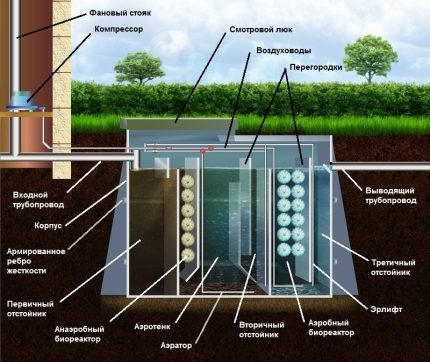
In the system, runoffs alternately pass through six zones:
- Septic chamber, or primary sedimentation tank;
- Anaerobic bioreactor;
- Aerotank;
- Secondary sedimentation tank;
- Aerobic bioreactor (aerotank of the II stage);
- Tertiary sedimentation tank.
Bioreactors are filled with ruffled nozzles. Aerators are installed in the bottom of the aeration tank and aerobic bioreactor chambers.
Airlifts are located in the secondary and tertiary sedimentation tanks and are connected by a sediment pipe to the septic chamber.
What is a case?
The septic tank is a sealed container made of durable polypropylene. This structural material is not susceptible to corrosion and any kind of erosion, does not enter into a chemical reaction with substances contained in soil and sewage.
On the sides of the casing are horizontal reinforced stiffeners, which, combined with the elasticity of polypropylene, allow the tank to withstand the pressure of the soil.
When properly installed with the device around the foundation pit, a dense sand cushion, even frosty heaving and uneven extrusion of individual layers of soil will not harm the septic tank.
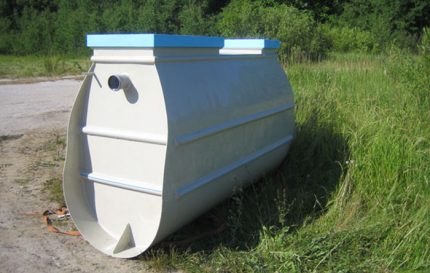
The special shape of the tank - trapezoidal with a rounded smooth bottom - is convenient for maintenance. There are no dead zones inside the tank and the septic tank can be cleaned of sludge even with the help of nets. The working sections of the station are arranged alternately in the horizontal direction, so the tank is elongated and has a relatively small height.
This feature allows you to place a septic tank in the upper layers of the soil, which reduces labor costs for earthwork and makes it possible to use the structure even at very high aquifer.
In the upper part of the tank one or two inspection hatchways are made.Due to their large size, the Tver septic tank is one of the most easily maintained facilities among the deep cleaning stations on the market.
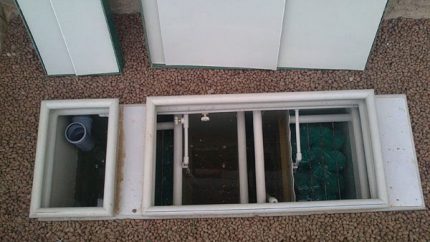
The device bioreactors
Since a lot of work when cleaning wastewater from pollution is carried out by microorganisms, it is necessary to provide optimal conditions for their growth and reproduction in the septic tank. It is precisely this function that both bioreactors in the Tver septic tank perform.
A physical opportunity for biofilm formation is provided by bio-loading. Its main function is to create as large a free area as possible for the settlement of bacterial colonies with minimal intrinsic dimensions.
In bioreactors of the Tver wastewater treatment plant, ruff loading is used. Nozzles resemble the shape of an ordinary household ruff, for which they got their name.
The shape of the loading elements contributes to the growth of activated sludge and a uniform distribution of microflora. However, they do not clog like porous bio-loads.
The specific surface of the brush nozzles is 50-60 m2 / m3. Chemically stable polymeric materials from which they are made are absolutely safe for microorganisms and the environment.
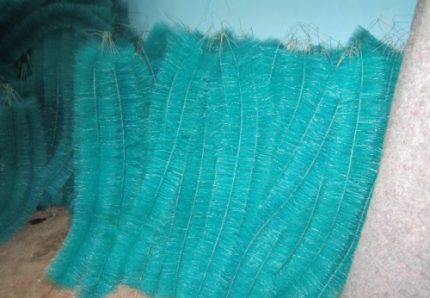
In anaerobic bioreactor settled bacteria coloniesthat live and breed without access to air. For their livelihoods, a sufficient amount of organic matter is sufficient.
The aerobic bioreactor provides conditions for microorganisms living only in the presence of oxygen. For this, an aerator is installed in the tank.
What is an aerator?
An aerator is a device that saturates the contents of a septic tank with the active component of air - oxygen. In its simplest form, it is simply a perforated tube, on one side of which air is supplied under pressure, and on the other, a plug is installed.
Gas is squeezed out through openings and, in accordance with physical laws, rises up. Since the aerator is installed at the very bottom, the entire volume of the section is filled with air bubbles. Oxygen dissolves in water and allows aerobic bacteria to exist.
However, if the air supply stops, the liquid will begin to flow into the nozzle of the aerator, which is unacceptable. Therefore, a special film is put on the nozzle. The air from the inside quietly passes through the micropores, forming tiny bubbles that saturate the water well with oxygen. Water does not leak back.
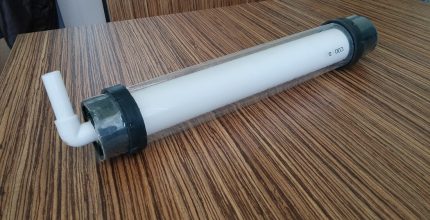
How does this sewer system work?
The process is organized in flow mode - the fluid goes through all stages of gravity cleaning. Therefore, a power outage does not become a disaster - the compartments do not overflow and the station continues to function and perform high-quality cleaning for at least a day.
Such design features allow you to effectively use the Tver septic tank both for summer cottages with seasonal or periodic use, and for a house with permanent residence.
In the tank, the effluents pass through four degrees of fine biological treatment.
Primary sedimentation and anaerobic fermentation
Through sewage pipes, sewage enters the primary sump, where sedimentation, mechanical separation takes place and treatment with microorganisms begins. Hydrobionts come here together with drains from the anaerobic bioreactor, as well as with activated sludge from the secondary and tertiary sedimentation tanks.
Under the influence of bacteria, large heavy structures are split, and the wastewater is stratified by specific gravity.Heavy, poorly soluble particles settle to the bottom, light fat fractions rise to the surface.
Sludge and grease film are also gradually processed, but this takes more time. As a result, only a solid precipitate remains, which should be pumped out.
The next section is the anaerobic bioreactor, where colonies of anaerobic bacteria are concentrated. Relatively clean water from the middle layer of the septic chamber gets here.
Due to the content of a large amount of organic matter, fermentation and sedimentation of sludge on the fibers takes place in the loading space. Hydrobionts break down difficultly oxidized and complex organic compounds to simple ones.
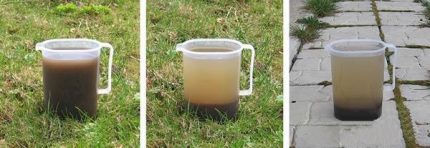
Oxidation and aerobic decomposition of organics
Water with simple suspensions falls into the next section - aeration tank, where continuous aeration is carried out. In an oxygenated and nutrient-rich environment, aerobic bacteria begin to work. They use simple organics as food to maintain metabolism. As a result, the water is saturated with active suspensions.
A layer of gravel is poured onto the bottom of the aeration tank. Residues of bacterial activity (metabolites) settle on it, as well as some of the organics. Due to this, an environment is formed for the reproduction and growth of anaerobes and the formation of activated sludge occurs.
Together with air bubbles, it rises again, and bacteria continue to work throughout the chamber. Further, this “agitated” liquid enters the secondary sump. The process calms down, the particles settle.
The secondary sump and aeration tank are interconnected sections, therefore, activated sludge settling returns to the aeration tank chamber. The clarified water flows through the upper overflows - into the aerobic bioreactor.
In the bioreactor chamber, conditions have been created for the growth and reproduction of huge colonies of aerobes. Saturated with oxygen and organic residues, water passes through a ruffian bio-load, in which the same processes occur as in an aeration tank. Only much more active.
The lion's share of activated sludge settles on the fibers of ruffs and is processed by bacteria until complete decomposition.

Neutralization of toxic compounds
In addition to organic matter and insoluble heavy suspensions, domestic wastes contain toxic substances. Detergents and cleaners used for bathing, washing, washing dishes or cleaning contain phosphates and nitrogen compounds.
They dissolve in water and do not settle, are not decomposed by bacteria. It is forbidden to drain the water containing toxic compounds into the ground - this threatens a violation of the environment.
To neutralize them, a limestone layer is located in the bottom region of the bioreactor section. It reacts with phosphates and nitrogen compounds and forms insoluble salts that precipitate.
Finishing sedimentation and disinfection
The last stage of treatment is the settling of water in a tertiary sump. The remaining metabolites and neutral salts formed by the combination of phosphates and limestone settle here. As a result of passing through all chambers, the effluents are completely cleaned of pollution - the degree of purification is 98%.
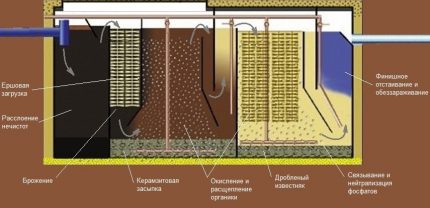
In a tertiary sump, almost pure water is disinfected. To do this, chlorine-containing tablets are placed in a special float.
Treated water can be discharged into relief and into a natural body of water.However, resource-saving trends are spreading not only in Europe, but also in our country.
Therefore, more and more economical owners use purified sewage a second time - for irrigation, for technical or household needs.
Disposal of excess activated sludge
With a sufficient amount of nutrients, the increase in the biomass of aerobic bacteria is very intense. In this case, a lot of activated sludge is formed. For disposal of its excess in the secondary and tertiary sedimentation tanks installed airlifts.
Airlift is a jet pump that lifts a fluid through compressed air. The design is very simple - it consists of two tubes and a compressor. One of the pipes is air under pressure. It is brought to the bottom of the second pipe, lowered into the water.
An air-water emulsion is formed - a liquid filled with air bubbles. Its specific gravity is less than the specific gravity of the surrounding water pipe.
Due to this, it rises up the pipe - denser water just pushes the lighter air-water mixture. Suspensions contained in the water also become part of the emulsion and successfully rise.
Two airlifts installed in the Tver septic tank, together with the liquid, raise excess activated sludge from the sections of the aeration tank and the tertiary sump. The mixture is pumped into the septic chamber through the sediment pipe. The cycle closes.
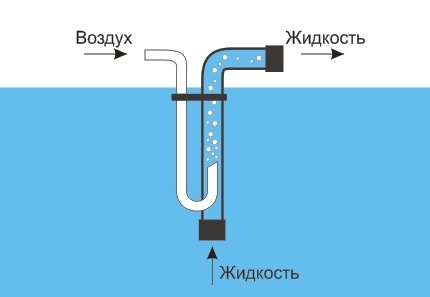
Advantages and disadvantages of the treatment system
Tver septic tanks have advantages and disadvantages, like any technical device. However, the number of advantages significantly outweighs, so these treatment facilities are widely and successfully used.
Design Advantages:
- Complete water purification takes place in one tank - no additional filtering devices are required.
- A septic tank with the right performance will purify effluents by 98% - this water can be discharged onto a relief, into a pond, and used for household needs.
- The septic tank case is made of high-strength polymer material that is not subject to corrosion and erosion, which ensures a long life of the device.
- There is no need to constantly use bioactivators - the bacteria in the septic tank recover independently and actively multiply.
- Purification from toxic phosphates and nitrogen compounds is provided.
- Solid sludge is pumped out once a year or less.
- The Tver Septic can be used even during intermittent operation - thanks to the combined cleaning method, the intermittent cycle does not create a large load on activated sludge and, in the absence of power supply, the septic tank goes into sleep mode.
- In a septic tank, the liquid does not move through the pipes or hoses, so there is no danger of clogging the system.
- The design quietly withstands salvo wastewater discharges without loss of treatment quality.
- Large inspection hatches make it easy to conduct routine inspections of the system, maintenance and pumping of solid sludge.
- The compressor is located indoors - this is convenient for maintenance and significantly extends the life of the unit.
- Compact overall dimensions and light weight allow carrying out installation of a septic tank Tver on their own, without the involvement of special equipment.
Disadvantages:
- System volatility;
- The high price of the complex.
However, the rather high cost of a septic tank pays off already during installation - no need build absorption wells or spend money on arrangement of a filtration field.
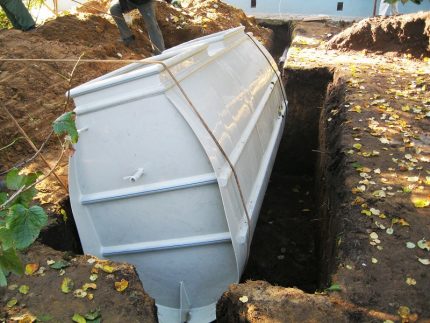
Modifications of treatment facilities “Tver”
Executions of Tver septic tanks are classified according to their productivity - the amount of effluent that the plant is able to process within 24 hours. Select the required volume of the tank, taking into account the number of people constantly living in the house.
The performance of the modifications of Tver stations on the market starts at 0.35 cu. m per day - this is suitable for 1-2 people. Next come the performances Tver-0.5P and Tver-0.75P - for 2-3 residents, Tver-0.85P - for 3-5 residents, Tver-1P - for 4-6 inhabitants, etc.
The letter "P" in the designation means that the septic tank is made in a plastic case.
The maximum daily processing volume for a septic tank with a plastic housing has a modification Tver-3P. This design can serve up to 18 people.
Septic tanks with a higher productivity belong to the professional class, their body is made of steel. The productivity of such structures is from 4.5 to 500 cubic meters. m per day.
Available with pump compartments. The section with the pump may be the last one along the septic tank. Such modifications have the letter “H” at the end of the cipher designations - for example, Tver-1,5PN.
Pumping units are used for forced removal of purified water to a relief or to a well when the level of the discharge pipe is higher than the outlet from the septic tank.
There are models with a pump compartment, which is located in front of the receiving chamber - the primary settler. Sewage pump pumps sewage into the septic chamber in the case when the trunk leaving the house is located quite low underground - below 60 cm it is the surface level.
Septic tanks with a pump are marked with the letter “H” at the beginning of the cipher designations - Tver-1NP.
There are also combined installations - their designation has the code of the NPN. For example, performance Tver-2NPN.
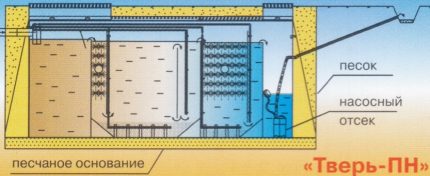
If the issue of septic tank selection is still relevant, we suggest that you read the article - Which septic tank is better for home: a comparison of popular treatment plants
Conclusions and useful video on the topic
The device and principle of operation of the Tver septic tank:
The device and operation of the Tver septic tank, its advantages in comparison with other systems. Winter Conservation Tips:
Septic tank “Tver”, due to its versatility, is used for private houses and summer cottages located in areas with any type of soil. More productive designs are suitable for the disposal of effluents from small production sites and storage facilities, remote from central communications.
Share with your readers your experience using the Tver septic tank. Please tell us about the features of its maintenance and operation. Participate in discussions and ask your questions - the comment block is located below.

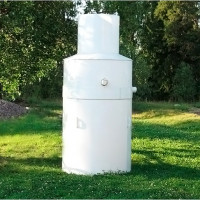 Overview of the cedar septic tank: device, principle of operation, advantages and disadvantages
Overview of the cedar septic tank: device, principle of operation, advantages and disadvantages 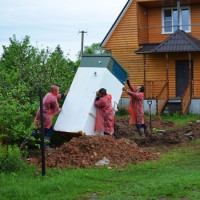 Overview of the Eco-Grand septic tank: device, principle of operation, advantages and disadvantages of the system
Overview of the Eco-Grand septic tank: device, principle of operation, advantages and disadvantages of the system 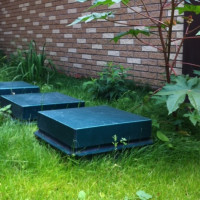 Overview of the septic tank “Leader”: device, principle of operation, advantages and disadvantages
Overview of the septic tank “Leader”: device, principle of operation, advantages and disadvantages 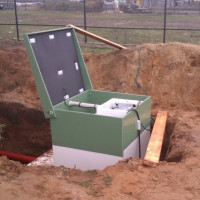 Overview septic tank for giving “Topas”: principle of operation, device, advantages and disadvantages
Overview septic tank for giving “Topas”: principle of operation, device, advantages and disadvantages 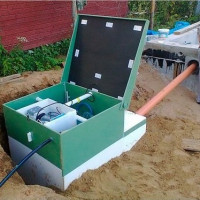 Overview of the septic tank “Eurobion Yubas”: device, advantages and disadvantages, comparison with competitors
Overview of the septic tank “Eurobion Yubas”: device, advantages and disadvantages, comparison with competitors 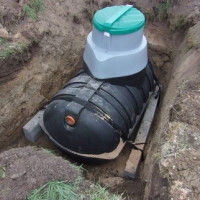 Overview of the Rostock septic tank: device, lineup, advantages and disadvantages
Overview of the Rostock septic tank: device, lineup, advantages and disadvantages  How much does it cost to connect gas to a private house: the price of organizing gas supply
How much does it cost to connect gas to a private house: the price of organizing gas supply  The best washing machines with dryer: model rating and customer tips
The best washing machines with dryer: model rating and customer tips  What is the color temperature of light and the nuances of choosing the temperature of the lamps to suit your needs
What is the color temperature of light and the nuances of choosing the temperature of the lamps to suit your needs  Replacement of a geyser in an apartment: replacement paperwork + basic norms and requirements
Replacement of a geyser in an apartment: replacement paperwork + basic norms and requirements
It's amazing how some companies work! I called several companies in search of a septic tank at my cottage. Often, managers do not even know their product! And recently I talked with engineers - competent consultations. They picked me up a horizontal septic tank Tver, reliable and practical. No complicated electronics. Reinforced, with anchors from the ascent. Interested in.
Googled, thought, weighed everything and decided to take it. Installed in the country quickly, managed a day. By the way, we are visiting there, I did not want the hassle of sewage. Therefore, Tver just turn off and that's it. Even in the winter. Convenient, practical, reliable. Recommend.
“Tver” is thought out in everything at first glance, and I consider it a priority for the acquisition. But I still have some doubts about the fact that the installation is completely dependent on bioreactors. It turns out that there is an option of accidentally destroying the right bacteria with any household chemicals ?! And the second: to go on vacation and leave the installation unattended really ?!
Good afternoon, Anatoly. A small amount of household chemicals is allowed in the septic tank. Naturally, if you dump only chemistry, then the concentration will reach a dangerous level for bacteria.
Categorically can not be dumped into the septic tank:
- bones;
- seeds from fruit and berries;
- fabric materials;
- alcohols and acids.
Turn off the compressor and boldly leave. Aerobic bacteria are found in organic impurities. After arrival, turning on the compressor and dropping organic waste, they will immediately begin to multiply.
It is recommended that you add live bacteria and the septic tank will be restored immediately. If this is not possible, then you can try replacing with ordinary kefir. Kefir will perform two actions:
1. Contains live bacteria.
2. Act as a stimulating food for live bacteria.
“Tver” is one of the easiest septic tanks to operate and therefore one of the most reliable.
Good afternoon. There is a house in the village in which from 1 to 5 people live in summer and short visits (3-5 times) during the winter. Those. the house stands unheated and de-energized almost all winter.
Which septic tank option is better suited to such conditions? Clay soil and groundwater are periodically over-ground - in spring, a well flows over the edge. I look at the “Tver”, but I doubt that he will survive for 4-6 months without anything at all.
In summer, the pump starts from the well with a storage tank on the roof and everything merges into a bucket. And the toilet is just bio. I would like to modernize, because older people live. It’s hard for them to walk with buckets. But with the calculation of only summer operation and periodic (2-3 days) power outages. Or, under such conditions, only bio and buckets?
In this case, you need a completely sealed septic tank, which should be located below the depth of freezing of the soil. AT this article You can find useful information on preparing a septic tank for winter.I also advise reading comments where a person has a similar question. As a heater, it is recommended to use extruded polystyrene.
If you plan to disconnect electricity upon departure, then septic tanks such as “Tver” or “Topas” will not work, since for their full-fledged operation, power supply is necessary. In your case, if you are considering ready-made options, I recommend a septic tank of the “BARS” type, of domestic production. The principle of its operation is such that it can function without electricity even in winter.
With a limited budget, it is better to mount a septic tank yourself from concrete rings and insulate with extruded polystyrene.